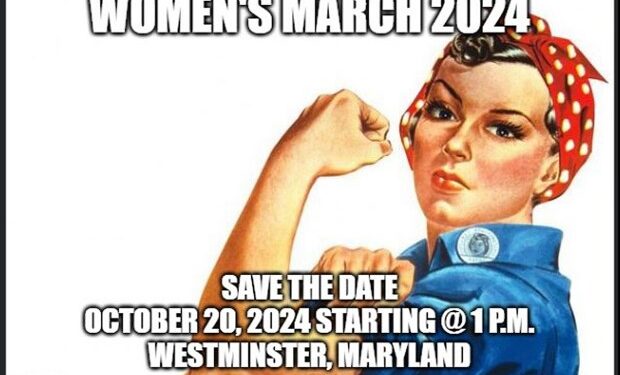Women have always been essential in community leadership and development locally and in our great nation. And it certainly can be said that women are currently playing an outsized role in national politics at the moment.
In the spring 2024 edition of the McDaniel publication, “The Hill,” the second woman to serve as McDaniel’s president, Julia Jasken wrote, “Although we are only a few months into 2024, women have already reached some pretty impressive new heights … Rear Admiral Yvette Davids is the first woman to be named superintendent of the U.S. Naval Academy, and Jenny Cavnar became the first woman play-by-play announcer in Major League Baseball history.”

Jasken follows in the footsteps of the first woman president of McDaniel, Joan Develin Coley, and has been joined in Carroll County by the first woman president of Carroll Community College, Rose Mince.
Additionally, we are fortunate to have a long list of locally elected leaders including, to mention a few: Carroll County municipal mayors, Melinda Smith, Mona Becker, and Stacy Link. Former Carroll County Commissioner Julia Gouge, current Circuit Court Clerk Heather DeWees, and a host of municipal council women throughout the county.
This Sunday, Oct. 20, folks from throughout the mid-Maryland region will gather at Westminster’s historic City Hall for a Women’s March to “raise awareness of women’s issues;” according to Pam Zappardino.
After folks assemble at City Hall at 1838 Emerald Hill Lane, they will step off at 1 p.m. for a walk up to Main Street, to Court Street, around the courthouse, and back to City Hall by way of Willis Street.

It is only fitting and appropriate that the group assemble at City Hall. It is the ancestral home of Sarah Longwell, a prominent member of the community in the 1800s.
Beginning in 1832, Sarah Longwell and her husband Col. John K. Longwell published a newspaper, the “Maryland Recorder,” in Taneytown. A year or so later they moved the paper to Westminster, where he established “The Carrolltonian.” Subsequently, they played the leading role in the formation of Carroll County out of parts of Frederick and Baltimore counties.
The Longwells built a house, referred to as “Longwell Place” in 1842. In September 1939, nearly a hundred years later, the Westminster Mayor and Common County purchased the property for $11,000. In 1942, the city offices were moved from the old Westminster Fire Engine and Hose Co., No.1 building at 63 W. Main St., to Longwell Place, now known as Emerald Hill, and it became known as City Hall.

Westminster expanded rapidly 50 years after the Civil War. Along with the growth came many growing pains. Nancy Warner, my Westminster High School classmate, writes in her book, “Carroll County Maryland, A History 1837-1976;” the major force behind reform and civic improvement were women’s civic leagues, whose main goals were to promote “morality and purity among the people of the community, especially the young and to improve sanitary conditions within the towns.”
Carroll County’s patron saint, Mary Bostwick Shellman, started the annual Memorial Day parade in Westminster in 1868. She was involved in early scouting and was a faithful volunteer for the poor and needy at the Carroll County Alms House – now known as the Farm Museum.
No discussion of the distinguished daughters of Carroll County would be complete without a mention of international journalist and photographer Sadie Kneller Miller. She was born in Westminster in 1867. According to research by Keith Richwine, a professor of English at McDaniel College and local writer, Mary Ann Ashcraft, Miller worked for many years for Leslie’s Illustrated Weekly. She covered the building of the Panama Canal around 1908, and in 1914, she traveled to Mexico to cover a series of military expeditions against the Mexican revolutionary leader Poncho Villa. Her death on Nov. 26, 1920, was national and international news. She is buried in the Westminster cemetery on Church Street in Westminster.
By the end of the 19th century, women in the community began a concerted effort to bring about public improvements in town. In the late 1880s, there was a plan to provide water systems, get the street and sidewalks uniformly graded and paved and in the late 1890s, electric streetlights were on their way.

According to Warner’s book, “Westminster had the first Civic League, organized in January 1913 with Mrs. Charles E. Stewart, president; Mrs. Frank Z. Miller, secretary; and Mrs. George K. Mather, treasurer.”
In the years before Carroll County went “dry” on May 1, 1915 – almost five years before prohibition took effect in January 1920 for the rest of the country — Shellman was noted as being determined to banish Westminster’s 21 saloons, according to Ms. Warner. Bear in mind, that during this period, Westminster had around 3,000 citizens.
According to research by Cathy Baty, the former curator of collections for the Historical Society of Carroll County, on May 13, 1957, the first woman was selected for jury duty in Carroll County.
Today, more than ever, we need all hands on deck. We have all greatly benefited from the support of a continued Carroll County commitment that believes in the power of diversity in an open, inclusive, and welcoming community.
Kevin Dayhoff writes from Westminster. His Time Flies column appears every Sunday. Email him at [email protected].







